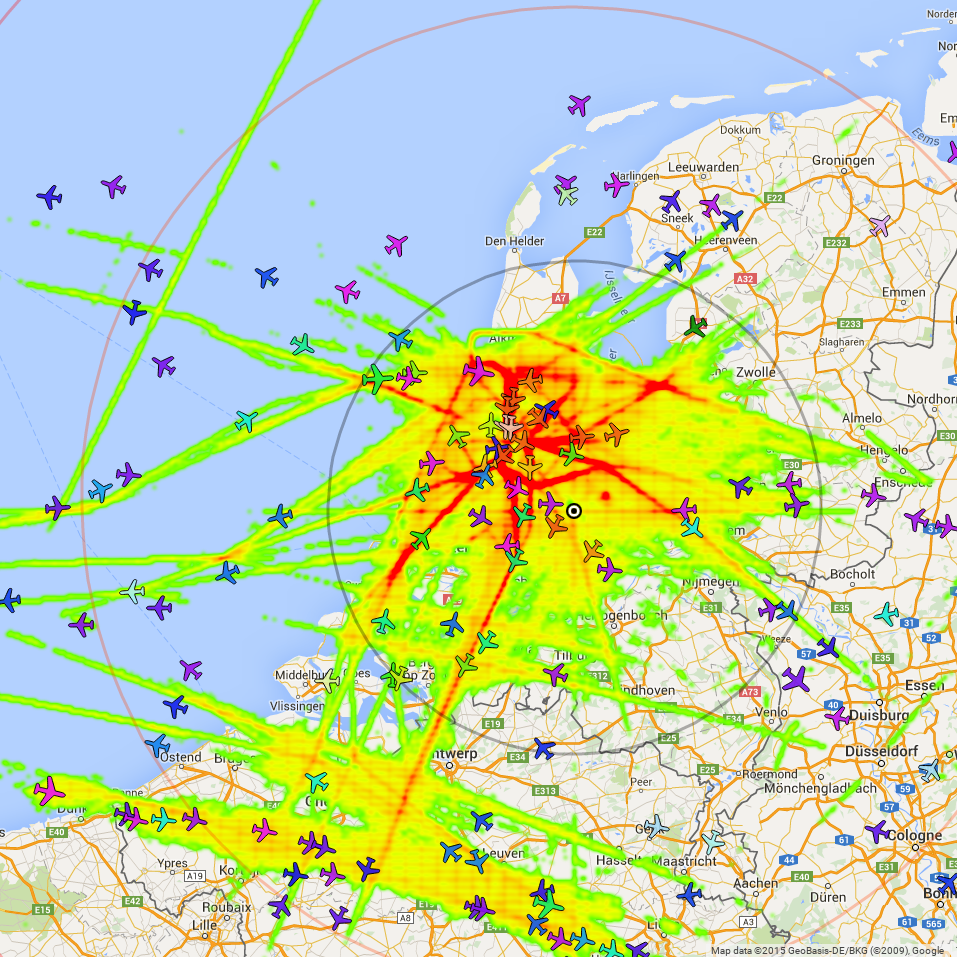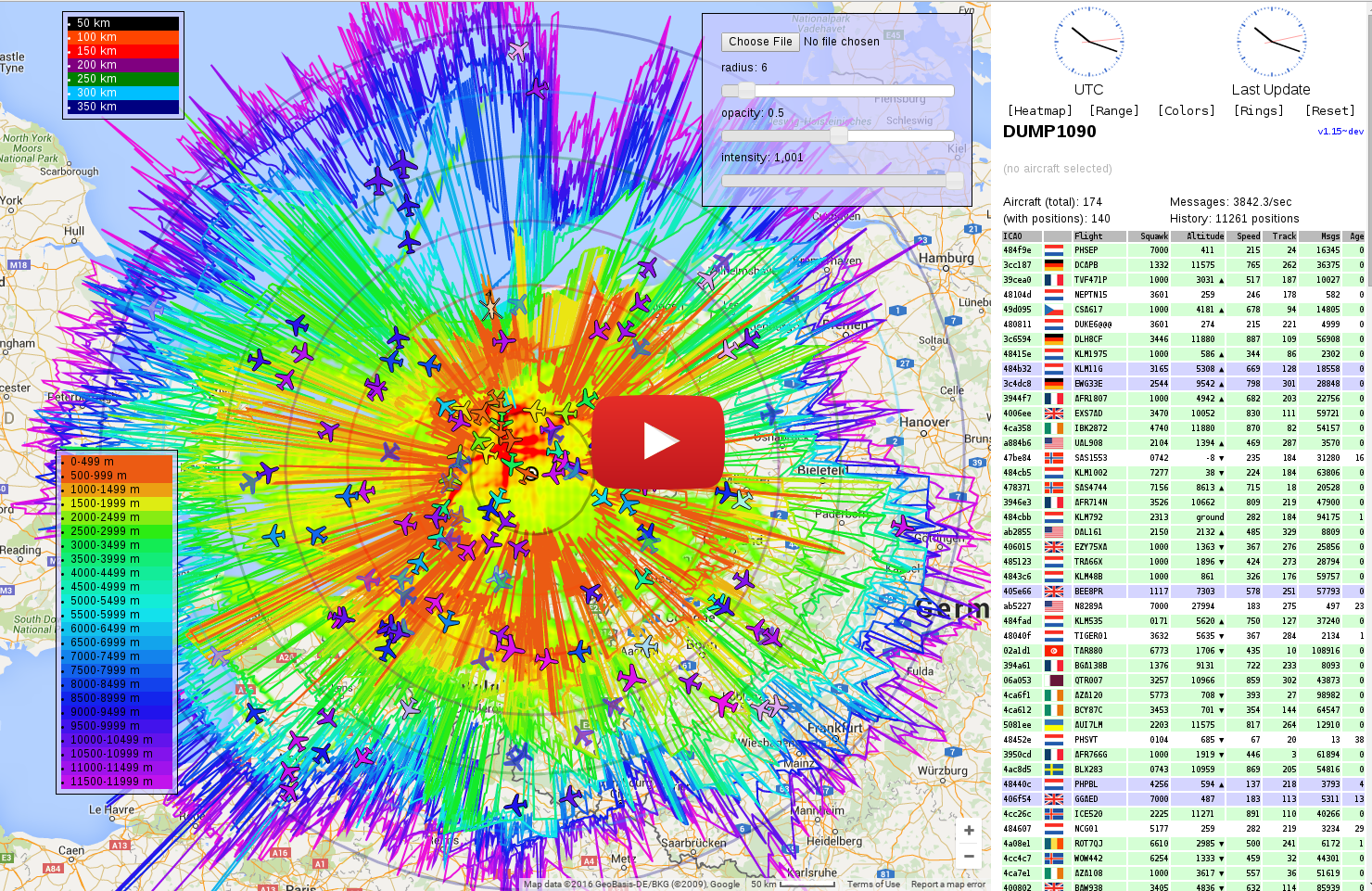dump1090.socket30003
Table of contents
- dump1090.socket30003
Collect flight data for heatmap and rangview
Use your dump1090 to collect flight data and create a heatmap and rangeview.
Screenshots and video
Heatmap. What are the flight paths through the air.

Rangeview. How far is the reach of your antenna.

The scripts
socket30003.pl
- Collects dump1090 flight positions (ADB-S format) using a tcp socket 30003 stream
and save them in csv format.
heatmap.pl
- Reads the flight positions from files in csv format and creates points for a heatmap.
- The heatmap shows where planes come very often. It makes common routes visable.
- Output in csv format (Google maps format).
rangeview.pl
- Reads the flight positions from files in csv format and creates a range/altitude view map.
- The range/altitude view shows the maximum range of your antenna for every altitude zone.
- KML output support (Google maps format).
install.pl
- Simpel installer script.
socket30003.cfg
- config file for socket30003.pl, heatmap.pl, rangeview.pl and install.pl
The output heatmapdata.csv and rangeview.kml can be displayed in a my modified variant of dump1090-mutability: https://github.com/tedsluis/dump1090
Read more about this at: http://discussions.flightaware.com/topic35844.html
Help page socket30003.pl
This socket30003.pl script can retrieve flight data (like lat, lon and alt)
from a dump1090 host using port 30003 and calcutates the distance and
angle between the antenna and the plane. It will store these values in an
output file in csv format (seperated by commas) together with other flight
data.
This script can run several times simultaneously on one host retrieving
data from multiple dump1090 instances on different hosts. Each instance
can use the same directories, but they all have their own data, log and
pid files. And every day the script will create a new data and log file.
A data files contain column headers (with the names of the columns).
Columns headers like 'altitude', 'distance' and 'ground_speed' also contain
their unit between parentheses, for example '3520(feet)' or '12,3(kilometer)'.
This makes it more easy to parse the columns when using this data in other
scripts. Every time the script is (re)started a header wiil be written
in to the data file. This way it is possible to switch a unit, for
example from 'meter' to 'kilometer', and other scripts will still be able
to determine the correct unit type.
By default the position data, log files and pid file(s) will be stored in this format:
dump1090-<hostname/ip_address>-<YYMMDD>.txt
dump1090-<hostname/ip_address>-<YYMMDD>.log
dump1090-<hostname/ip_address>.pid
The script can be lauched as a background process. It can be stopped by
using the -stop parameter or by removing the pid file. When it not
running as a background process, it can also be stopped by pressing
CTRL-C. The script will write the current data and log entries to the
filesystem before exiting...
More info at:
http://discussions.flightaware.com/post180185.html#p180185
Syntax: socket30003.pl
Optional parameters:
-peer <peer host> A dump1090 hostname or IP address.
De default is the localhost, 127.0.0.1.
-restart Restart the script.
-stop Stop a running script.
-status Display status.
-data <data directory> The data files are stored in /tmp by default.
-log <log directory> The log file is stored in /tmp by default.
-pid <pid directory> The pid file is stored in /tmp by default.
-msgmargin <max message margin> The max message margin. The default is 10 ms.
-lon <lonitude> Location of your antenna.
-lat <latitude>
-distanceunit <unit> Type of unit for distance: kilometer,
nauticalmile, mile or meter
Default distance unit is kilometer.
-altitudeunit <unit> Type of unit for altitude: meter or feet.
Default altitude unit is meter.
-speedunit <unit> Type of unit for ground speed.
Default speed unit is kilometerph.
-nopositions Does not display the number of position while
running interactive (launched from commandline).
-debug Displays raw socket messages.
-verbose Displays verbose log messages.
-help This help page.
Notes:
- To launch it as a background process, add '&' or run it from crontab:
0 * * * * /home/tedsluis/git/dump1090.socket30003/socket30003.pl
(This command checks if it ran every hour and relauch it if nessesary.)
- The default values can be changed within the config file 'socket30003.cfg',
section [common] and/or [socket30003].
Examples:
socket30003.pl
socket30003.pl -log /var/log -data /home/pi -pid /var/run -restart &
socket30003.pl -peer 192.168.1.10 -nopositions -distanceunit nauticalmile -altitudeunit feet &
socket30003.pl -peer 192.168.1.10 -stop
Pay attention: to stop an instance: Don't forget to specify the same peer host.Output socket30003.pl
- Default outputfile: /tmp/dump1090-192_168_11_34-150830.txt (dump1090-
- .txt) hex_ident,altitude(meter),latitude,longitude,date,time,angle,distance(kilometer),squawk,ground_speed(kilometerph),track,callsign 484CB8,3906,52.24399,5.25500,2017/01/09,16:35:02.113,45.11,20.93,0141,659,93,KLM1833 406D77,11575,51.09984,7.73237,2017/01/09,16:35:02.129,111.12,212.94,,,,BAW256 4CA1D4,11270,53.11666,6.02148,2017/01/09,16:35:03.464,40.85,130.79,,842,81,RYR89VN 4B1A1B,3426,51.86971,4.14556,2017/01/09,16:35:03.489,-103.38,68.93,1000,548,352,EZS85TP 4CA79D,11575,51.95681,4.17119,2017/01/09,16:35:03.489,-98.28,64.41,1366,775,263,RYR43FH hex_ident,altitude(feet),latitude,longitude,date,time,angle,distance(mile),squawk,ground_speed(mileph),track,callsign 48500,1416,52.53923,4.95834,2017/01/09,16:41:40.885,-15.42,51.21,1000,377,279,TRA5802 478690,11141,50.66931,3.43764,2017/01/09,16:41:40.886,-131.71,194.76,5325,542,37,SAS22K 34260E,10966,51.77884,5.07965,2017/01/09,16:41:40.888,-178.31,34.11,1114,522,214,IBE32HP 484558,5071,52.48020,4.22715,2017/01/09,16:41:40.892,-64.42,73.22,6260,459,303,KLM55U 4951B7,11270,52.78214,2.43583,2017/01/09,16:41:40.901,-74.55,195.81,2375,442,40,TAP766note: As you can see it is possible to switch over to different type units for 'altitude', 'distance' and 'ground speed'!
Help page heatmap.pl
This heatmap.pl script creates heatmap data
which can be displated in a modified variant of dump1090-mutobility.
It creates an output file with location data in csv format, which can
be imported using the dump1090 GUI.
Please read this post for more info:
http://discussions.flightaware.com/post180185.html#p180185
This script uses the data file(s) created by the 'socket30003.pl'
script, which are by default stored in '/tmp' in this format:
dump1090-<hostname/ip_address>-YYMMDD.txt
The script will automaticly use the correct units (feet, meter,
kilometer, mile, natical mile) for 'altitude' and 'distance' when
the input files contain column headers with the unit type between
parentheses. When the input files doesn't contain column headers
(as produced by older versions of 'socket30003.pl' script)
you can specify the units using startup parameters or in the config
file. Otherwise this script will use the default units.
This script will create a heatmap of a square area around your
antenna. You can change the default range by specifing the number
of degrees -/+ to your antenna locations. (The default values will
probably satisfy.) This area will be devided in to small squares.
The default heatmap has a resolution of 1000 x 1000 squares.
The script will read all the flight position data from the source
file(s) and count the times they match with a square on the heatmap.
The more positions match with a particular square on the heatmap,
the more the 'weight' that heatmap position gets. We use only the
squares with the most matches (most 'weight) to create the heatmap.
This is because the map in the browser gets to slow when you use
too much positions in the heatmap. Of cource this also depends on
the amount of memory of your system. You can change the default
number of heatmap positions. You can also set the maximum of
'weight' per heatmap position.
Syntax: heatmap.pl
Optional parameters:
-data <data directory> The data files are stored in
'/tmp' by default.
-log <log directory> The data files are stored in
'/tmp' by default.
-output <output The data files are stored in
directory> '/tmp' by default.
-file <filename> The output file name.
'heatmapdata.csv' by default.
-filemask <mask> Specify a filemask for the source data.
The default filemask is 'dump*.txt'.
-override Override output file if exists.
Default is 'no'.
-timestamp Add timestamp to output file name.
Default is 'no'.
-sequencenumber Add sequence number to output file name.
Default is 'no'.
-lon <lonitude> Location of your antenna.
-lat <latitude>
-maxpositions <max Maximum spots in the heatmap. Default is
positions> '100000' positions.
-maxweight <number> Maximum position weight. The default is
'1000'.
-resolution <number> Number of horizontal and vertical positions
in output file. Default is '1000',
which means '1000x1000' positions.
-degrees <number> To determine boundaries of area around the
antenna. (lat-degree <--> lat+degree) x
(lon-degree <--> lon+degree)
De default is '5' degree.
-debug Displays raw socket messages.
-verbose Displays verbose log messages.
-help This help page.
note:
The default values can be changed within the config file
'socket30003.cfg', section [common] and section [heatmap].
Examples:
heatmap.pl
heatmap.pl -data /home/pi -log /var/log
heatmap.pl -lat 52.1 -lon 4.1 -maxposition 50000Output heatmap.pl
- Default output file: /tmp/heatmapdata.csv
"weight";"lat";"lon" "1000";"52.397";"4.721" "919";"52.389";"4.721" "841";"52.405";"4.721" "753";"52.413";"4.721" "750";"52.517";"5.297" "743";"52.317";"5.177" "679";"51.925";"2.849" "641";"51.853";"6.065" "609";"51.229";"3.649"Help page rangeview.pl
This rangeview.pl script creates location data for a range/altitude view which can be displated in a modified fork of dump1090-mutobility.
The script creates two output files: rangeview.csv) A file with location data in csv format can be imported in to tools like http://www.gpsvisualizer.com. rangeview.kml) A file with location data in kml format, which can be imported into a modified dum1090-mutability.
Please read this post for more info: http://discussions.flightaware.com/post180185.html#p180185
This script uses the output file(s) of the 'socket30003.pl' script, which are by default stored in /tmp in this format: dump1090-<hostname/ip_address>-YYMMDD.txt
It will read the files one by one and it will automaticly use the correct units (feet, meter, mile, nautical mile of kilometer) for 'altitude' and 'distance' when the input files contain column headers with the unit type between parentheses. When the input files doesn't contain column headers (as produced by older versions of 'socket30003.pl' script) you can specify the units.Otherwise this script will use the default units.
The flight position data is sorted in to altitude zones. For each zone and for each direction the most remote location is saved. The most remote locations per altitude zone will be written to a file as a track.
Syntax: rangeview.pl
Optional parameters:
-data The data files are stored in
'/tmp' by default.
-log The log files are stored in
'/tmp' by default.
-output <output The output file is stored in
directory> '/tmp' by default.
-file
'rangeview.kml' by default.
-filemask
-distanceunit
notes:
- The default values can be changed within the config file 'socket30003.cfg'.
- The source units will be overruled in case the input file header contains unit information.
Examples: rangeview.pl rangeview.pl -distanceunit kilometer,nauticalmile -altitudeunit meter,feet rangeview.pl -data /home/pi/data -log /home/pi/log -output /home/pi/result
### Output rangeview.pl
* Default output file: /tmp/rangeview.csvtype,new_track,name,color,trackpoint,altitudezone,destination,hex_ident,Altitude(meter),latitude,longitude,date,time,angle,distance(kilometer) T,1,Altitude zone 1: 00000- 500,7fffff00,1, 0,-718,484646,357,52.00493,5.08865,2017/01/10,10:46:15.738,-179.72,8 T,0,Altitude zone 1: 00000- 500,7fffff00,2, 0,-717,484646,357,52.00616,5.08808,2017/01/10,10:46:17.164,-179.32,8 T,0,Altitude zone 1: 00000- 500,7fffff00,3, 0,-714,484646,357,52.00788,5.08722,2017/01/10,10:46:19.740,-178.7,8 T,0,Altitude zone 1: 00000- 500,7fffff00,4, 0,-713,484646,357,52.00914,5.08667,2017/01/10,10:46:21.041,-178.28,8 T,0,Altitude zone 1: 00000- 500,7fffff00,5, 0,-711,484646,357,52.01039,5.08604,2017/01/10,10:46:22.622,-177.79,8 T,0,Altitude zone 1: 00000- 500,7fffff00,6, 0,-709,484646,357,52.01125,5.08560,2017/01/10,10:46:23.892,-177.44,8 T,0,Altitude zone 1: 00000- 500,7fffff00,7, 0,-708,484646,357,52.01230,5.08518,2017/01/10,10:46:25.244,-177.09,8 T,0,Altitude zone 1: 00000- 500,7fffff00,8, 0,-706,484646,357,52.01335,5.08461,2017/01/10,10:46:26.625,-176.62,8 T,0,Altitude zone 1: 00000- 500,7fffff00,9, 0,-704,484646,357,52.01463,5.08400,2017/01/10,10:46:28.031,-176.09,7 T,0,Altitude zone 1: 00000- 500,7fffff00,10, 0,-702,484646,357,52.01579,5.08345,2017/01/10,10:46:29.475,-175.59,7 T,0,Altitude zone 1: 00000- 500,7fffff00,11, 0,-700,484646,357,52.01683,5.08293,2017/01/10,10:46:30.940,-175.11,7
* Default output file: /tmp/rangeview.kml<?xml version="1.0" encoding="UTF-8"?>
